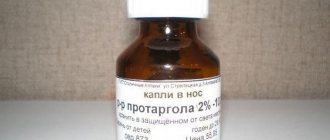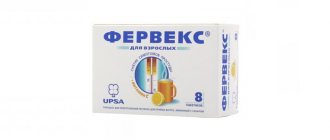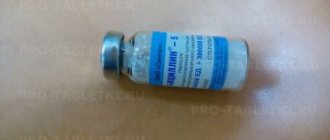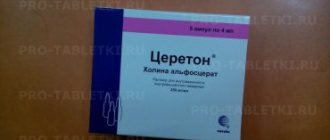pharmachologic effect
Acts bactericidal. Endowed with broad antimicrobial effect. Shows activity not only against gram-positive microorganisms, but is also active against gram-negative microorganisms, and against Leptospiraceae and Spirochaetaceae.
Rickettsia, fungi, viruses, protozoa, indole-positive strains of Proteus are resistant to the action of the drug.
Inhibits, like penicillins, the synthesis of the bacterial cell wall.
Pharmacokinetics
Cefazolin, when administered intramuscularly, is absorbed quickly, reaches its maximum concentration in the blood within an hour, and remains in the blood plasma in effective concentrations for 8-12 hours. Metabolized in the liver. Approximately 90% in the first six hours is excreted directly by the kidneys, unchanged, after 24 hours - 70-95%. T1/2 in case of functional kidney disorders - 3-42 hours.
It penetrates into the amniotic fluid and umbilical cord blood through the placental barrier. Regarding mother's milk, it is found in very low concentrations. Good penetration of Cefazolin into the joint cavities through the inflamed synovial membrane was noted. A higher concentration in the blood is observed with intravenous administration, but Cefazolin is released faster in this case, with a half-life of approximately 2 hours.
Directly with plasma proteins the connection is 85%.
During hemodialysis it is excreted moderately.
Pharmacokinetics
Suction
After intramuscular administration, Cmax in plasma is reached within 30-75 minutes.
Distribution
The binding of cefazolin to plasma proteins is about 65-92%. Cefazolin penetrates very well into tissues, including skeletal muscle, myocardium, bone tissue, bile and tissues of the gallbladder, endometrium and vagina.
Cefazolin crosses the placental barrier and is excreted in breast milk. Penetrates into the cerebrospinal fluid and intraocular fluid in small quantities.
Metabolism and excretion
Cefazolin is not metabolized. Most of the administered dose undergoes glomerular filtration and is excreted in the urine in a microbiologically active form. A small part is excreted in bile. T1/2 from plasma is about 2 hours.
Removal
In patients with impaired renal function, T1/2 may be longer.
Indications for use
Cefazolin is indicated for the following infectious and inflammatory diseases:
- peritonitis;
- sepsis;
- endocarditis;
- pleural empyema;
- lung abscess;
- pneumonia;
- osteomyelitis of wound infections;
- infected burns.
Infections:
- genitourinary tract (including gonorrhea and syphilis);
- respiratory tract;
- soft tissues and skin;
- infectious lesions of joints and bones.
Cefazolin contraindications
Hypersensitivity, neonatal period (up to 1 month).
With caution : Kidney failure, intestinal diseases (including a history of colitis), children under 1 year of age.
Use during pregnancy and lactation During pregnancy, it is prescribed only for health reasons (strictly controlled studies have not been conducted).
FDA category of effect on the fetus is B.
If it is necessary to prescribe the drug during lactation, breastfeeding should be stopped (cefazolin passes into breast milk).
Directions for use, dosage
Cefazolin is administered intravenously (drip or stream) and intramuscularly. A solution of the drug for intramuscular administration is prepared by diluting the powder in the bottle in 4-5 ml of 0.9% sodium chloride solution (sterile water is an alternative) and injected deeply into the muscle.
A single dose of the drug for intravenous jet administration should be diluted in 10 ml of 0.9% sodium chloride solution, then administered slowly over 3 to 5 minutes.
In the case of intravenous drip administration, 0.5 - 1.0 g of Cefazolin should be diluted in 100-250 ml of 0.9% sodium chloride solution (an alternative is 5% glucose solution). The injection is carried out over 20 to 30 minutes (60-80 drops are injected in 1 minute).
For adults, the dose of Cefazolin per day ranges from 1 g to 4 g (possibly more), directly depending on the severity of the infection, sensitivity to the antibiotic and the type of pathogen.
For infections caused by gram-positive microorganisms, a single dose of Cefazolin for adults is 0.25-0.5 g every eight hours.
For moderately severe respiratory tract infections caused by pneumococci, a dose of 0.5-1.0 g is indicated at an interval of every twelve hours, which is similar for urinary tract infections.
Cefazolin is indicated at 0.5 - 1.0 g at intervals of every six to eight hours for diseases caused by gram-negative microorganisms.
The daily dose for severe infections (peritonitis, sepsis, endocarditis, destructive pneumonia) can be increased to a maximum level of 6 g, with intervals of 6-8 hours between administrations.
Cefazolin for children over one month of age is prescribed a dosage per day of 20-50 mg/kg body weight (divided into three to four doses); for severe infections, a maximum dose of 100 mg/kg is recommended.
The treatment regimen for adults with excretory dysfunction is adjusted, the dose of Cefazolin is reduced, and the intervals between administrations are increased. Despite the degree of functional renal impairment, the initial dose is 0.5 g.
For the treatment of adults with functional renal impairment, the following doses are recommended for infections:
- mild or moderate severity (with creatine clearance within 40-70 ml/min and 20-34 mg% blood urea nitrogen) - a dose of 0.25-0.5 g with an interval of every 12 hours; in case of severe cases, a dose of 0.5-1.25 g is indicated, observing the interval - every 12 hours (5 hours is the half-life);
- mild or moderate severity (with creatine clearance 20-40 ml/min and 35-49 mg % BUN) - dose 0.125-0.25 g every 12 hours; in case of severe cases, a dose of 0.25-0.6 g is indicated, observing the interval - every 12 hours (with a half-life of 6-12 hours);
- mild or moderate severity (with creatine clearance 5-20 ml/min and BUN - 50-75 mg%) - dose 75-150 mg every 24 hours; in case of severe cases, a dose of 150-400 g is indicated, observing the interval - every 24 hours (with a half-life of 15-30 hours);
- mild or moderate severity (with creatine clearance 5 ml/min and BUN - 75 mg%) - dose 37.5-75 mg every 24 hours; in case of severe disease, a dose of 75-200 mg is indicated at intervals - every 24 hours (30-40 hours is the half-life).
Regarding children with functional impairment of renal function, a single dose of Cefazolin is administered at the initial stages, then the dosage is adjusted according to the degree of the disease.
In children with moderate functional renal impairment, the dose per day is:
- clearance of creatine within the range of 40 to 70 ml/min - 60% of the daily dose used in the case of normal kidney function is divided into two administrations;
- clearance of creatine within the range of 20 to 40 ml/min - 25% of the daily dose used in the case of normal kidney function, divided into two administrations;
- Creatine clearance ranges from 5 to 20 ml/min - 10% of the daily dose used in the case of normal kidney function, an interval of 24 hours should be observed.
You cannot mix Cefazolin solutions with any other antibiotics in the same infusion solution or in the same syringe. The duration of treatment depends on the severity and form of the disease.
Overdose
In case of an overdose of Cefazolin, the following symptoms are observed:
- headache;
- paresthesia;
- dizziness.
In patients diagnosed with chronic renal failure:
- neurotoxicosis;
- clonicotonic generalized convulsions;
- increased convulsive readiness;
- tachycardia;
- vomit.
Hemodialysis is recommended to remove the drug from the body.
Peritoneal dialysis shows ineffectiveness.
Side effects
Taking the drug causes side effects from:
Organs of the digestive system:
- constipation or diarrhea;
- feeling of nausea;
- vomit;
- abdominal pain;
- flatulence;
- gastrointestinal candidiasis;
- dysbacteriosis;
- functional liver disorders.
In rare cases:
- glossitis;
- stomatitis;
- cholestatic jaundice;
- hepatitis;
- pseudomembranous enterocolitis.
Hematopoietic organs:
- neutropenia;
- leukopenia;
- decrease in hematocrit;
- thrombocytopenia;
- granulocytopenia;
- hemolytic anemia;
- increase in prothrombin time.
Genitourinary system:
- anal itching;
- functional kidney disorders;
- itching of the genitals.
Allergic reactions:
- itching;
- hives;
- rash;
- chills;
- fever.
In rare cases:
- Zosinophilia;
- bronchospasm;
- anaphylactic shock;
- toxic epidermal necrolysis;
- angioedema;
- exudative erythema of a malignant nature;
- exudative erythema multiforme.
Local reactions:
- pain along the vein;
- phlebitis;
- at the site of intramuscular injection - infiltration and pain.
Other:
- candidiasis;
- superinfection.
Drug interactions
Simultaneous use of Cefazolin with diuretics and anticoagulants is not recommended.
The concentration of cefazolin in plasma is increased by loop diuretics and drugs that block tubular secretion.
Pharmaceutically incompatible with aminoglycosides, increases the likelihood of kidney damage.
Lidocaine cannot be used to prepare a solution intended for intravenous administration.
With simultaneous administration of probenecid, the renal clearance of Cefazolin is reduced.
When conducting laboratory tests to detect sugar content in urine using Benedict's solution, Clinitest tablets, Fehling's solution, false positive results are sometimes observed.
Cefazolin has no effect on the results of tests that detect sugar content in urine, which are based on enzymatic methods.
False-positive results may be recorded when conducting an antiglobulin test in newborns whose mothers used Cefazolin in their treatment.
Analogues of the drug
Analogues of Cefazolin are: Ancef, Cefazolin "Biochemi", Ifizol, Natsef, Lizolin, Cefamezin, Cefazolin-AKOS, Orizolin, Cezolin, Cefesol, Cefazolin Elfa, Cefazolin-Ferein, Cefopride, Cefazolin Sandoz.
special instructions
Patients with a history of allergic reactions to penicillins or carbapenems may have increased sensitivity to cephalosporin antibiotics.
During treatment with cefazolin, it is possible to obtain positive direct and indirect Coombs tests, as well as a false positive urine reaction to sugar.
When prescribing the drug, exacerbation of diseases of the gastrointestinal tract, especially colitis, is possible.
During the treatment period, care must be taken when driving vehicles and engaging in other potentially hazardous activities that require increased concentration and speed of psychomotor reactions.





![Soluble insulin [human genetically engineered]: trade name, list of drugs](https://mcgaide.ru/wp-content/uploads/insulin-rastvorimyj-chelovecheskij-genno-inzhenernyj-torgovoe-nazvanie-perechen-preparatov-330x140.jpg)




